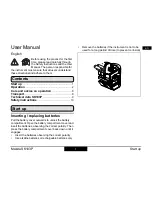
R =
x
(2)
30
RH [ft]
(d1 + d2) [inch]
4
R =
x
(1)
10
RH [m]
(d1 + d2) [mm]
4
7.1.3 Deactivating the automatic power-off feature
Switch the tool on, then off and on again within 3 seconds.
The laser beam blinks five times to confirm deactivation.
NOTE
The tool will be switched off when the on/off switch is
slid forward or when the batteries are exhausted.
7.2 Examples of applications
7.2.1 Setting out drywall track for a partition
wall
3
7.2.2 Setting up lighting elements
4
7.3 Checking
7.3.1 Checking the plumb point
5
1. Make a mark on the floor (a cross) in a high room
(e.g. in a stairwell or hallway with a height of 5–10
m).
2. Place the tool on a smooth, level (horizontal) surface.
3. Switch the tool on.
4. Position the tool with the lower beam on the center
of the cross.
5. Mark the position of the vertical beam on the ceiling.
Attach a piece of paper to the ceiling before making
the mark.
6. Pivot the tool through 90°.
NOTE
The lower plumb beam must remain on the
center of the cross.
7. Mark the position of the vertical beam on the ceiling.
8. Repeat the procedure after pivoting the tool through
180° and 270°.
NOTE
The resulting 4 marks form a circle in which
the intersection of the diagonals d1 (1-3) and d2
(2-4) marks the exact center of the plumb point.
9. Calculate the accuracy as described in section
7.3.1.1.
7.3.1.1 Calculation of accuracy
The result (R) provided by this formula (RH = room height)
refers to the tool’s accuracy “in mm at 10 m” (formula
(1)). This result (R) should be within the specification for
the tool: 3 mm at 10 m
8 Care and maintenance
8.1 Cleaning and drying
1. Blow dust off the glass.
2. Do not touch the glass with the fingers.
3. Use only a clean, soft cloth for cleaning. If necessary,
moisten the cloth slightly with pure alcohol or a little
water.
NOTE
Do not use any other liquids as these may
damage the plastic components.
4. Observe the temperature limits when storing your
equipment. This is particularly important in winter
/ summer if the equipment is kept inside a motor
vehicle (-25°C to +60°C).
8.2 Storage
Remove the tool from its case if it has become wet.
The tool, its carrying case and accessories should be
cleaned and dried (at maximum 40°C / 104°F). Repack
the equipment only once it is completely dry.
Check the accuracy of the equipment before it is used
after a long period of storage or transportation.
Remove the batteries from the tool before storing it for a
long period. Leaking batteries may damage the tool.
8.3 Transport
Use the original packaging or packaging of equivalent
quality for transporting or shipping your equipment.
CAUTION
Always remove the batteries before shipping the tool.
8.4 Hilti calibration service
We recommend that the tool is checked by the Hilti cal-
ibration service at regular intervals in order to verify its
reliability in accordance with standards and legal require-
ments.
Use can be made of the Hilti calibration service at any
time, but checking at least once a year is recommended.
The calibration service provides confirmation that the
tool is in conformance, on the day it is tested, with the
specifications given in the operating instructions.
The tool will be readjusted if deviations from the man-
ufacturer’s specification are found. After checking and
adjustment, a calibration sticker applied to the tool and
a calibration certificate provide written verification that
the tool operates in accordance with the manufacturer’s
specification.
Calibration certificates are always required by companies
certified according to ISO 900x.
Your local Hilti Center or representative will be pleased
to provide further information.
en
6
Printed: 08.07.2013 | Doc-Nr: PUB / 5130772 / 000 / 01






























